Abstract
This review is a a series of the authors' studies designed to test the hypothesis that administration of trichloroethylene (TCE), dichloroethylene (DCE), their metabolites, and related compounds are responsible for fetal cardiac teratogenesis when given to pregnant rats during organogenesis. Identification of teratogenic compounds will allow more accurate assessment of environmental contaminants and public health risks. Epidemiologic studies and previous teratogenic studies using chick embryos and fetal rats have reported an increased number of congenital cardiac defects when exposed to TCE or DCE during fetal development. Metabolites of TCE and DCE studied in the drinking-water exposure study include trichloroacetic acid TCAA), monochloroacetic acid, trichloroethanol, carboxymethylcysteine, trichloroacetaldehyde, dichloroacetaldehyde, and dichlorovinyl cysteine. Varying doses of each were given in drinking water to pregnant rats during the period of fetal heart development. Rats receiving 2730 ppm TCAA in drinking water were the only metabolite group demonstrating a significant increase in the number of cardiac defects in fetuses on a per-litter basis (p = 0.0004 Wilcoxon test and p =0.0015 exact permutation test). Maternal and fetal variables showed no statistically significant differences between treated and untreated groups. When treated with TCAA the increased cardiac defects, as compared to controls, do not preclude the involvement of other metabolites as cardiac teratogens, but indicates TCAA as a specific cardiac teratogen. Further studies of drinking-water exposure and potential mechanisms of action on the developing heart are proceeding.
Full text
PDF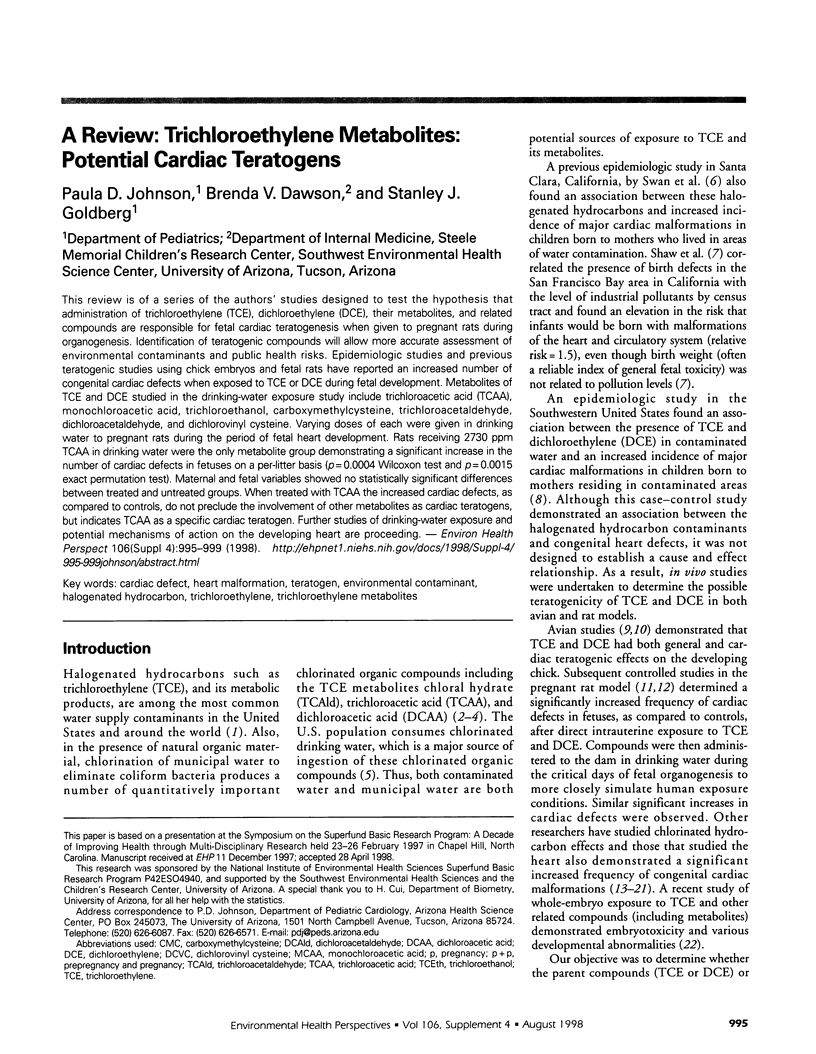
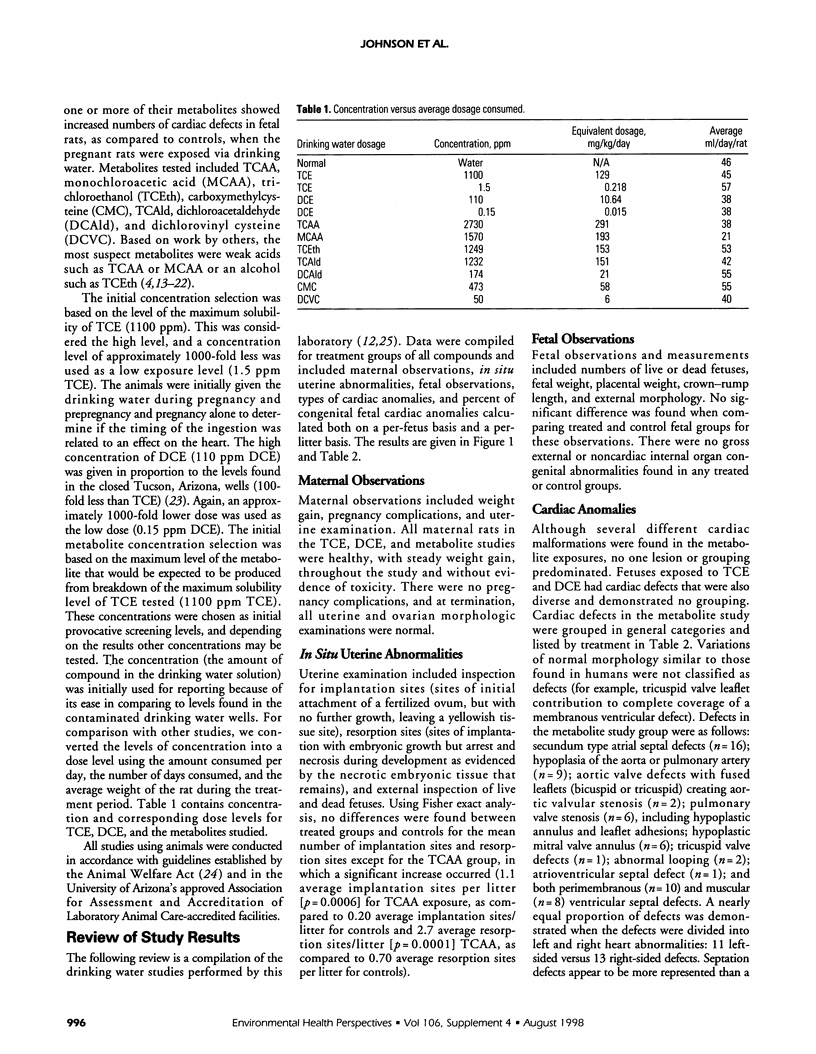
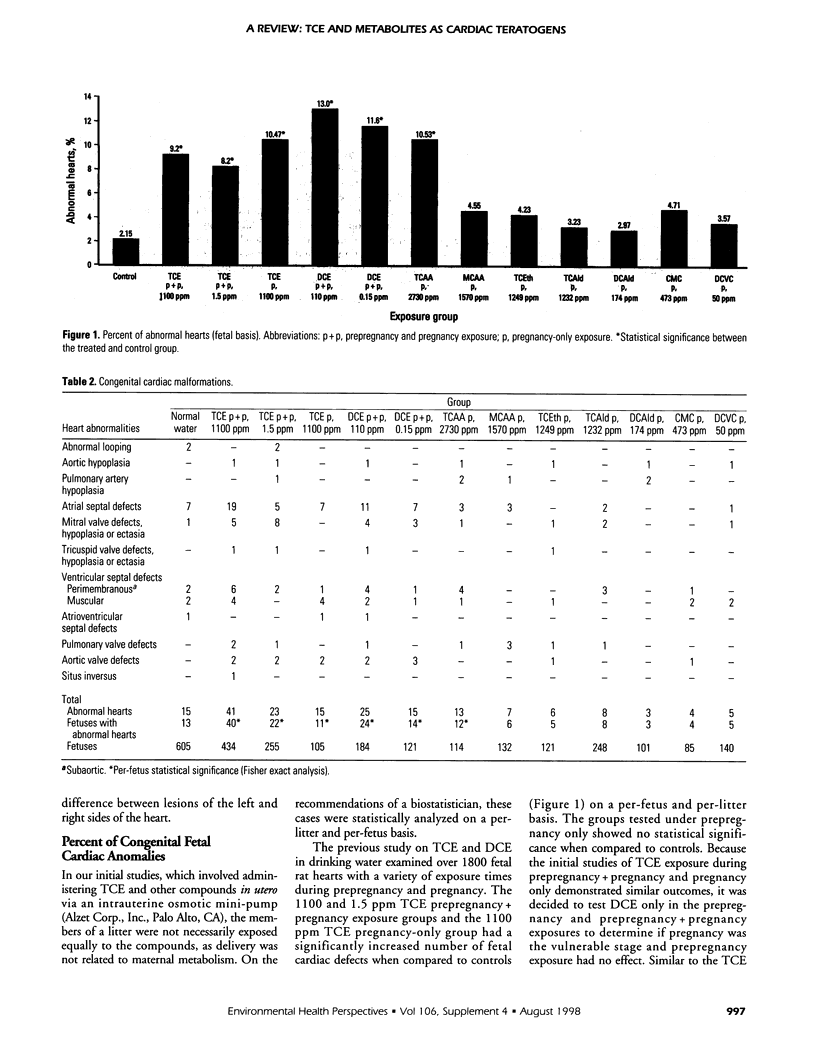
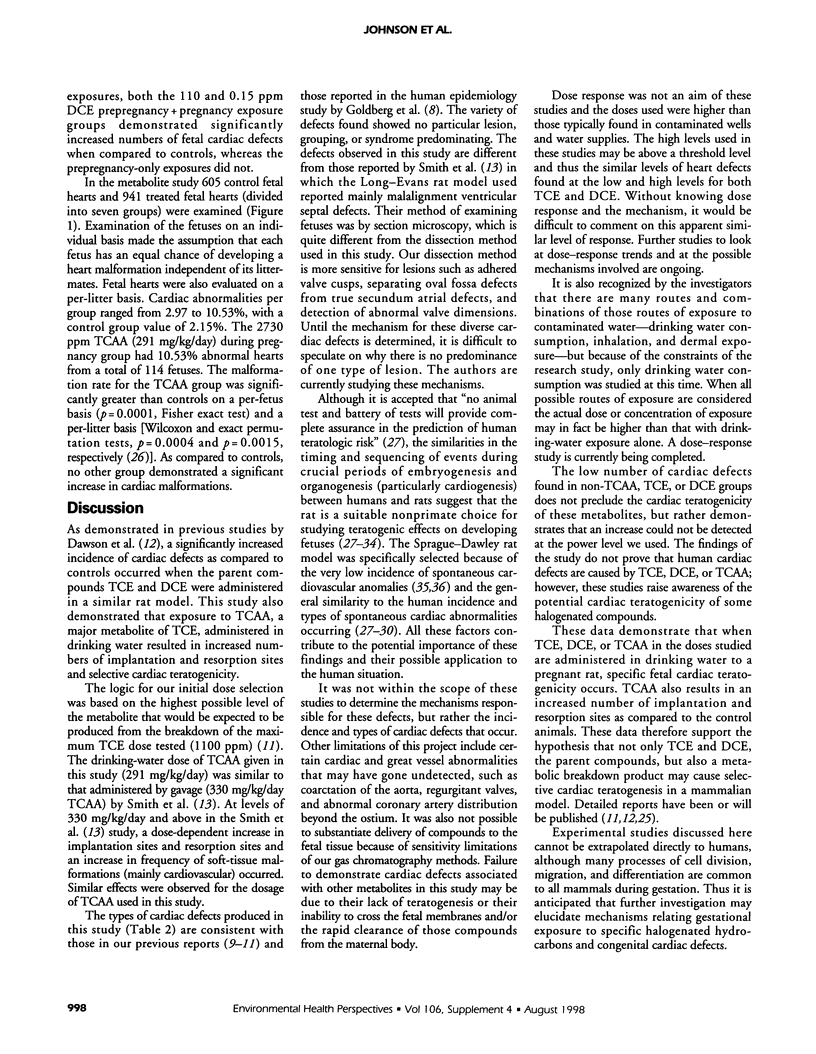
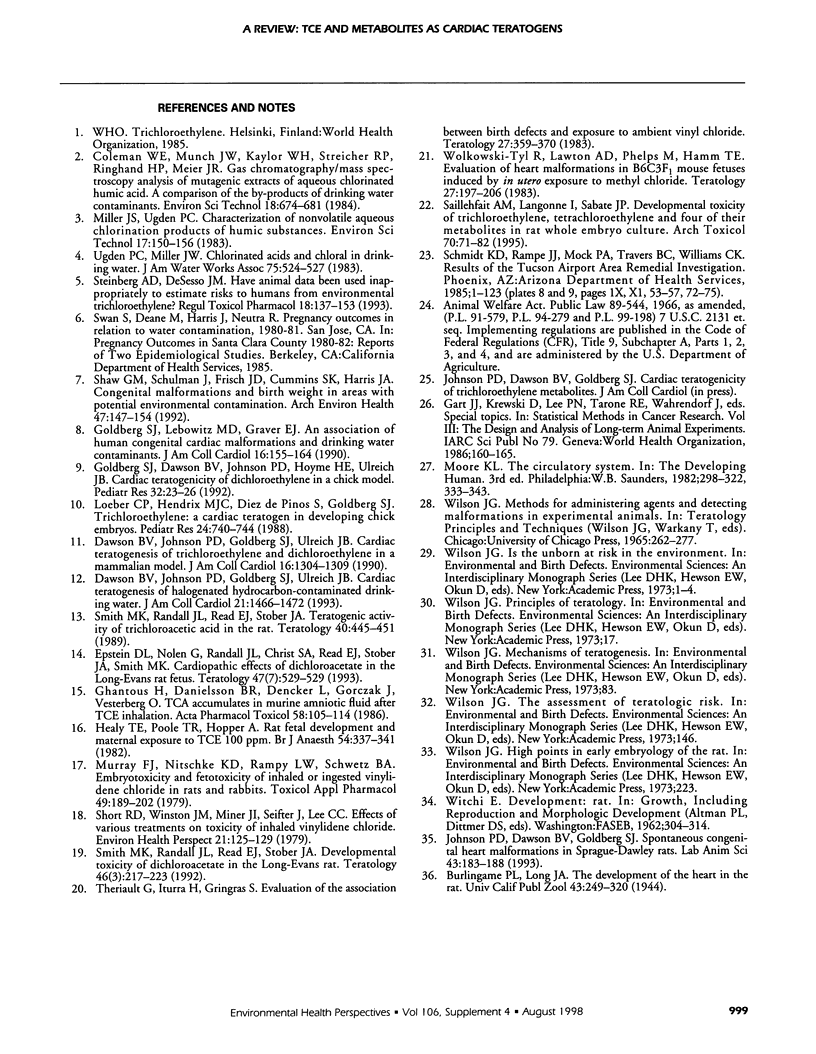
Images in this article
Selected References
These references are in PubMed. This may not be the complete list of references from this article.
- Dawson B. V., Johnson P. D., Goldberg S. J., Ulreich J. B. Cardiac teratogenesis of halogenated hydrocarbon-contaminated drinking water. J Am Coll Cardiol. 1993 May;21(6):1466–1472. doi: 10.1016/0735-1097(93)90325-u. [DOI] [PubMed] [Google Scholar]
- Dawson B. V., Johnson P. D., Goldberg S. J., Ulreich J. B. Cardiac teratogenesis of trichloroethylene and dichloroethylene in a mammalian model. J Am Coll Cardiol. 1990 Nov;16(5):1304–1309. doi: 10.1016/0735-1097(90)90569-b. [DOI] [PubMed] [Google Scholar]
- Ghantous H., Danielsson B. R., Dencker L., Gorczak J., Vesterberg O. Trichloroacetic acid accumulates in murine amniotic fluid after tri- and tetrachloroethylene inhalation. Acta Pharmacol Toxicol (Copenh) 1986 Feb;58(2):105–114. doi: 10.1111/j.1600-0773.1986.tb00078.x. [DOI] [PubMed] [Google Scholar]
- Goldberg S. J., Dawson B. V., Johnson P. D., Hoyme H. E., Ulreich J. B. Cardiac teratogenicity of dichloroethylene in a chick model. Pediatr Res. 1992 Jul;32(1):23–26. doi: 10.1203/00006450-199207000-00005. [DOI] [PubMed] [Google Scholar]
- Goldberg S. J., Lebowitz M. D., Graver E. J., Hicks S. An association of human congenital cardiac malformations and drinking water contaminants. J Am Coll Cardiol. 1990 Jul;16(1):155–164. doi: 10.1016/0735-1097(90)90473-3. [DOI] [PubMed] [Google Scholar]
- Healy T. E., Poole T. R., Hopper A. Rat fetal development and maternal exposure to trichloroethylene 100 p.p.m. Br J Anaesth. 1982 Mar;54(3):337–341. doi: 10.1093/bja/54.3.337. [DOI] [PubMed] [Google Scholar]
- Johnson P. D., Dawson B. V., Goldberg S. J. Spontaneous congenital heart malformations in Sprague Dawley rats. Lab Anim Sci. 1993 Apr;43(2):183–188. [PubMed] [Google Scholar]
- Loeber C. P., Hendrix M. J., Diez De Pinos S., Goldberg S. J. Trichloroethylene: a cardiac teratogen in developing chick embryos. Pediatr Res. 1988 Dec;24(6):740–744. doi: 10.1203/00006450-198812000-00018. [DOI] [PubMed] [Google Scholar]
- Murray F. J., Nitschke K. D., Rampy L. W., Schwetz B. A. Embryotoxicity and fetotoxicity of inhaled or ingested vinylidene chloride in rats and rabbits. Toxicol Appl Pharmacol. 1979 Jun 30;49(2):189–202. doi: 10.1016/0041-008x(79)90241-2. [DOI] [PubMed] [Google Scholar]
- Saillenfait A. M., Langonné I., Sabaté J. P. Developmental toxicity of trichloroethylene, tetrachloroethylene and four of their metabolites in rat whole embryo culture. Arch Toxicol. 1995;70(2):71–82. doi: 10.1007/BF02733666. [DOI] [PubMed] [Google Scholar]
- Shaw G. M., Schulman J., Frisch J. D., Cummins S. K., Harris J. A. Congenital malformations and birthweight in areas with potential environmental contamination. Arch Environ Health. 1992 Mar-Apr;47(2):147–154. doi: 10.1080/00039896.1992.10118769. [DOI] [PubMed] [Google Scholar]
- Short R. D., Winston J. M., Minor J. L., Seifter J., Lee C. C. Effect of various treatments on toxicity of inhaled vinylidene chloride. Environ Health Perspect. 1977 Dec;21:125–129. doi: 10.1289/ehp.7721125. [DOI] [PMC free article] [PubMed] [Google Scholar]
- Smith M. K., Randall J. L., Read E. J., Stober J. A. Developmental toxicity of dichloroacetate in the rat. Teratology. 1992 Sep;46(3):217–223. doi: 10.1002/tera.1420460305. [DOI] [PubMed] [Google Scholar]
- Smith M. K., Randall J. L., Read E. J., Stober J. A. Teratogenic activity of trichloroacetic acid in the rat. Teratology. 1989 Nov;40(5):445–451. doi: 10.1002/tera.1420400506. [DOI] [PubMed] [Google Scholar]
- Steinberg A. D., DeSesso J. M. Have animal data been used inappropriately to estimate risks to humans from environmental trichloroethylene? Regul Toxicol Pharmacol. 1993 Oct;18(2):137–153. doi: 10.1006/rtph.1993.1049. [DOI] [PubMed] [Google Scholar]
- Thériault G., Iturra H., Gingras S. Evaluation of the association between birth defects and exposure to ambient vinyl chloride. Teratology. 1983 Jun;27(3):359–370. doi: 10.1002/tera.1420270310. [DOI] [PubMed] [Google Scholar]
- Wolkowski-Tyl R., Lawton A. D., Phelps M., Hamm T. E., Jr Evaluation of heart malformations in B6C3F1 mouse fetuses induced by in utero exposure to methyl chloride. Teratology. 1983 Apr;27(2):197–206. doi: 10.1002/tera.1420270207. [DOI] [PubMed] [Google Scholar]



